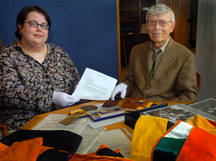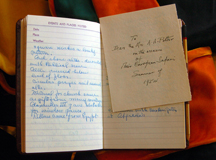
August 31, 2004
Earhart papers, collections database available online
WEST LAFAYETTE, Ind. – Thousands of Amelia Earhart's papers and artifacts are among two of Purdue University Libraries' historic collections that now have detailed online catalogs, known as finding aids, making it easy for users to see what is in the collections.

|
Purdue Libraries' first archivist, Sammie Morris, said she made the development of these two online aids her priority when she started at Purdue nearly a year ago. She completed the Earhart collection in six months and then started on the papers and relics of engineering education pioneer and former Purdue dean of engineering, Andrey A. Potter.
"It took approximately six months for me to finish work on the Earhart collection, because I had to create an entirely new arrangement scheme and consolidate the two separate Earhart collections before I could begin processing and writing the finding aid," Morris said. "Some preservation work was also needed for the collection, such as encapsulating documents (sealing documents between layers of archival plastic), preservation photocopying and re-housing them into acid-free containers."

|
Digitized portions of The George Palmer Putnam Collection of Earhart Papers also are now available online. Included in the online collection are documents regarding Earhart's 1932 solo Atlantic flight, her second and fatal attempt at a world flight in 1937 and items related to her time at Purdue. To access the finding aids for the digital collection and the actual collection, go to Amelia Earhart Papers web site and then click on "Finding Aids."
"The finding aids identify all of the different materials in each collection," Morris said. "By viewing a finding aid, a researcher, student or anyone can locate documents or items they would like to view, then make an appointment to come view those items and papers firsthand. The amount of time saved for the library and our users is tremendous."
While the Earhart collection is the most well known, the Potter collection is the most voluminous, consisting of 38 boxes, each 1 cubic foot. Users must contact the archives and special collections unit in advance to view the collection.
The process of cataloging the items in such a large and as yet undocumented collection was at once arduous and exhilarating, Morris said.
"My greatest joy is that of discovery, the notion that what you find in a box could be an historic treasure," Morris said. "There is no way to be closer to people in history than to see their documents and belongings. Amelia Earhart was a poet. She was afraid of growing old.
"These are not facts that many people are aware of, but the ability to see what's available via the finding aid makes it easy for almost anyone to get to know her history firsthand. Until a researcher has held and smelled and interacted with the actual documents and artifacts, he or she has not fully benefited from all a collection has to offer."
One value of viewing actual documents rather than just going by the research of others is the possibility of discovering that common knowledge about a subject may not be truth.
"If you look in some biographies of Amelia Earhart, they state that she was born in 1898, when in fact she was born in 1897. She lied about her age. She was vain about aging. Until you go to the original source, you don't know the whole story."
The Earhart and Potter collections contain a variety of research materials and memorabilia. The Potter collection includes written correspondence (some from past presidents of the United States), photographs, scrapbooks, honors, awards, doctoral hoods, robes and other artifacts. One former student of Potter's, Walter Veon, 92, of Indianapolis, recently donated a letter he received from Potter to the Purdue archives.
It seemed only right to library administrators that Veon be invited to be one of the first to view the Potter collection after the cataloging was complete. Veon and his late wife, Saraellen, also a Purdue graduate, donated $1.2 million to Purdue Libraries. Their gift was used to help renovate the Humanities, Social Science and Education Library with the creation of the Walter and Saraellen Veon Electronic Reference Center.
The digitization of the finding aid for the Earhart and Potter collections is in keeping with the spirit and intent of the Electronic Reference Center. The Veons, both members of the Class of 1934, kept up with the advances in technology and understood the need to modernize access to the library's collections. While digital access is important, Veon said there is nothing that can compare with seeing these historic artifacts in person.
"It's just like taking a step back in time to see and touch the papers and belongings of Dean Potter," Veon said. "I almost feel like I'm there again, although he wasn't dean when I was at Purdue. He was one of my engineering instructors. He always made everyone feel important. He remembered your name and never spoke down to anyone. He was the opposite of the stereotype of the engineer. He was a very warm and friendly man. It all came back to me so clearly when I was viewing his collection."
It is exactly those feelings Morris seeks to evoke by making the collections readily accessible with the help of the online finding aids. Anyone interested in either collection can decide what they want to view by researching the online finding aids and then making an appointment with Morris to see the items. Morris will then pull the requested documents and items from the collection and have them ready for viewing at the appointed date and time.
Anyone wishing to make an appointment to view items in the Earhart or Potter collections should contact Morris at (765) 494-2905, morris18@purdue.edu.
Writer: Reni Winter, (765) 496-3133, rwinter@purdue.edu
Sources: Sammie Morris, (765) 494-2905, morris18@purdue.edu
Judith Schumaker, Purdue Libraries, (765) 494-7987, jschumkr@purdue.edu
Purdue News Service: (765) 494-2096; purduenews@purdue.edu
Related Web sites:
Amelia Earhart Collection
PHOTO CAPTION:
Purdue archivist Sammie Morris, at left, shows Walter Veon, 92, Indianapolis, some of the items from the expansive Potter collection that is now available for viewing and research at Purdue Libraries. Veon studied engineering at Purdue while A.A. Potter was dean. (Purdue News Service photo/Dave Umberger)
A publication-quality photograph is available at https://www.purdue.edu/uns/images/+2004/morris-papers.jpg
PHOTO CAPTION:
One of former Purdue engineering Dean A.A. Potter's diaries, with a note from a friend written in 1954. (Purdue News Service photo/Dave Umberger)
A publication-quality photograph is available at https://www.purdue.edu/uns/images/+2004/morris-papers2.jpg
To the News Service home page